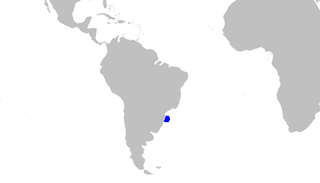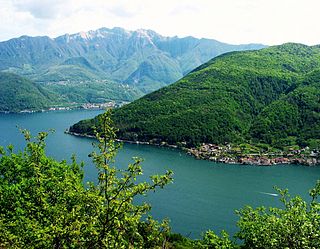
Limax maximus, known by the common names great grey slug and leopard slug, is a species of slug in the family Limacidae, the keeled slugs. It is among the largest keeled slugs, Limax cinereoniger being the largest.

Schizoglossa novoseelandica is a predatory species of air-breathing land slug or semi-slug, a terrestrial gastropod mollusc in the family Rhytididae. It is the type species of the genus Schizoglossa and is found only in New Zealand. The survival of this species is not threatened; it is not listed in the 2009 IUCN Red List nor is it in the 2005 New Zealand Threat Classification System lists.
Arion lusitanicus, also known by its common name Portuguese slug, is a species of air-breathing land slug, a terrestrial pulmonate gastropod mollusk in the family Arionidae.

The southern sawtail catshark is a species of catshark, part of the family Scyliorhinidae, endemic to southern Brazil. It inhabits deepwater reefs on the upper continental slope at a depth of 236–600 m (774–1,969 ft). Reaching at least 43 cm (17 in) in length, this slim-bodied species closely resembles the Antilles catshark. It has a prominent crest of enlarged dermal denticles along the dorsal edge of the caudal fin, as well as a distinctive color pattern of dark oval blotches, outlined in white, along its back. The southern sawtail catshark is oviparous, with females producing reddish egg capsules. The International Union for Conservation of Nature (IUCN) has assessed it as Vulnerable; it is often taken as bycatch and may be threatened by intensifying squid fishing.

Tandonia budapestensis is a species of air-breathing, keeled, land slug, a shell-less terrestrial gastropod mollusks in the family Milacidae.

The Kerry slug or Kerry spotted slug is a species of terrestrial, pulmonate, gastropod mollusc. It is a medium-to-large sized, air-breathing land slug in the family of roundback slugs, Arionidae.

Monte San Giorgio is a mountain and UNESCO World Heritage Site on the border between Switzerland and Italy. It is part of the Lugano Prealps, overlooking Lake Lugano in the Swiss Canton of Ticino.

Dryaderces inframaculata is a species of frog in the family Hylidae. It is endemic to Brazil and known from between the Tapajós and Xingu Rivers in Pará. Until recently, it was only known from one specimen collected near Santarém, probably around 1876, by Henry Wickham. Common name Santarem treefrog has been coined for it.

Ichthyophis sumatranus, also known as the Sumatra caecilian, is a species of amphibian in the family Ichthyophiidae. It is endemic to Sumatra, Indonesia. It is known from western Sumatra, but many records lack precise location data and its exact range is poorly known.
Craugastor myllomyllon is an extinct species of frog in the family Craugastoridae. It was endemic to Guatemala and only known from its type locality, Finca Volcan, in the Sierra de Xucaneb, Alta Verapaz Department. Only a single specimen is known.
Pristimantis lindae is a species of frog in the family Strabomantidae. It is endemic to Peru and only known from Kosñipata Valley on the northeastern slopes of the Cadena de Paucartambo, a frontal range of the Cordillera Oriental in Cusco Region. The specific name lindae honors Linda Trueb, an American herpetologist and wife of William E. Duellman, the species describer. Nevertheless, common name Santa Isabel robber frog has been coined for this species.
Chiasmocleis alagoana is a species of frogs in the family Microhylidae. It is endemic to remnants of the Atlantic rainforest in the states of Alagoas, Paraíba, and Pernambuco in north-eastern Brazil. The specific name alagoana refers to Alagoas, the state where this species was first found.
Nototriton brodiei is a species of salamander in the family Plethodontidae. It is endemic to the Sierra del Merendón and known from its type locality, Sierra de Caral in Izabal Department, eastern Guatemala, and from the Cusuco National Park in northwestern Honduras. The specific name brodiei honors Edmund D. Brodie Jr., an American herpetologist. Common name Cerro Pozo de Agua moss salamander has been coined for it.
The Beddomeia minima is a population of freshwater snails that are endemic to Australia. It is commonly called a hydrobiid snail. This population was listed as Vulnerable on the IUCN Red List in 2011 due to its distribution being restricted to a single location and range of possible threats present in Tasmania. The Beddomeia minima is one of a few fresh water snail species belonging to the same genus Beddomeia that survive in Tasmania, Australia, specifically a single location in the Scottsdale area.
Beddomeia protuberata is a species of endemic freshwater snails living in north-western Tasmania, Australia. The shells look ovate and periostracum yellow with some pustules, length between 2.29 mm and 2.93 mm and width between 2.01 mm and 2.34 mm. Beddomeia protuberata has 1.75 protoconch whorls. Its image of microsculpture is uniform and its wrinkles arranged weakly and helically. The teleoconch of beddomeia protuberata has 2.2 to 2.7 convex whorls, and the ratio of convexity is 0.15 to 0.24. Sculptures of the teleoconch are vague with prosocline growth lines. The margin of the last whorl is evenly circular. The thickness and width of inner lips are medium sizes, and the columellar swelled up prominently. The outer lips of beddomeia protuberata is prosocline, which means the shell leans forwards compared to the shell’s coiling axis. The width of their umbilicus is between 0.31 mm to 0.51 mm. The umbilicus of female beddomeia protuberata are wider than the umbilicus of male.
Edgbastonia coreena is a species of small freshwater snails which have an operculum, aquatic gastropod mollusks in the family Tateidae.

Tandonia is a genus of air-breathing, keeled, land slugs. These are shell-less terrestrial gastropod mollusks in the family Milacidae.

Tandonia rustica is a species of air-breathing, keeled, land slug, a shell-less terrestrial gastropod mollusc in the family Milacidae.
Tandonia serbica is a species of keeled air-breathing land slug, a terrestrial pulmonate gastropod mollusk in the family Milacidae.
The Stygian ringlet is a butterfly belonging to the subfamily Satyrinae, the "browns", within the family Nymphalidae. It is found locally in the Alps on dry limestone slopes. It is very similar to the Styrian ringlet and has sometimes been included in that species.











